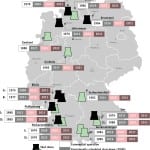A comprehensive legislative package passed by Germany’s federal cabinet and its bicameral legislature (comprising the Bundesrat, the federal council, and the Bundestag, the federal parliament) in the summer following Japan’s Fukushima nuclearcatastrophe in 2011 adopted 120 individual measures previously proposed in a 2010-unveiled “Energy Concept” and laid the groundwork for Germany to set its energy supply system on a new footing by the middle of the century.
The transition to a new energy era—described by the German term Energiewende —will be a “Herculean task,” German Chancellor Angela Merkel has admitted, bigger, perhaps, than efforts to bridge the infrastructure development gap following German reunification. But if the transition is successful, Germany could model how an export-oriented industrial nation staking its future on a high share of renewables can be globally competitive. If it stalls, the nation with the world’s fourth-largest economy by nominal gross domestic product could flounder economically, miring grandiose ambitions in the European Union (EU)—and around the world—to combat climate change with renewables.
Making an Energy Transition
The goals of the transition are certainly “ambitious” for Germany, an industrial heavyweight, but they are “clear,” Federal Minister of Economics and Technology Philip Rösler contends in a recent policy brochure. Along with a complete withdrawal from nuclear power by 2022, the country will strive to replace 80% of electricity generated today by conventional sources with renewables by 2050 and shave energy consumption by a fifth. Complex hurdles will have to be overcome, Rösler acknowledges. “[The transition] goes hand in hand with the necessary grids, power stations and storage technologies, and therefore involves the development of a completely new energy system,” he says. And the only way to achieve it without putting an “undue burden” on businesses and consumers and to ensure long-term acceptance of the transition is to prioritize “technology-neutral, market-oriented, and cost-effective instruments.”
It helps that Germany has been on a sustainability trajectory for awhile, some industry observers point out. The term Energiewende was coined three decades ago, in response to the oil shocks of the 1970s, by Öko-Institut, an ecological think tank that defined the transition as “growth and prosperity without oil or uranium.” That idea took root in political discourse during the 1980s, and in 1991, the first feed-in-tariff (FIT) policy backing renewables was introduced. After it was revised and extended in 2000, Germany enacted the Renewable Energy Sources Act ( Erneuerbare-Energien-Gesetz, or EEG)—the policy that perhaps most forcefully drives Germany’s post-Fukushima energy transition.
Nuclear’s Slow Death
In 2000, under then-Chancellor Gerhard Schröder, Germany’s first center-left coalition of Social Democrats (SDP) and the Green Party implemented a nuclear phase-out with the passage of Atomausstieg, a controversial policy change that stymied nuclear generators’ unlimited lifetime licenses and strong legal guarantees. Under that law, the country’s 19 then-operational nuclear plants were allotted a specific amount of electricity (2,623 billion kWh, or an average of 32 years) of lifetime production that they could feed to the grid before mandatory shutdown. It allowed those hefty allowances to be sold or transferred to other power plants for a profit, however, ameliorating protests from nuclear generators—particularly newly born E.ON, which amassed ownership of 12 of the 19 reactors after the merger of Germany’s biggest utilities, Veba and Viag. The industry-government compromise also included a government commitment not to introduce any “one-sided” taxation measures.
Just a decade later, in an attempt to lay the groundwork for future German energy policy to mitigate climate change, and—as a global recession raged—to reap a portion of tremendous profits utilities said they would earn if reactor lifetimes were extended from the average 32 years to 60 years (as in the U.S.), the coalition government of Chancellor Angela Merkel agreed to levy a €2.3 billion annual tax on the country’s four nuclear owners—RWE, E.ON, EnBW, and Vattenfall Europe. In return they got permission to operate reactors on average 12 years beyond 2021. The tax was to be used to subsidize renewables until at least 2016.
Merkel—a former environment minister in the mid-1990s under conservative Chancellor Helmut Kohl—was in September 2010 the head of a grand center-right coalition government that included her own liberal-conservative Christian Democratic Union (CDU), the Christian Social Union (CSU), and the business-friendly Free Democratic Party (FDP). She had then called the reactor lifetime extension compromise “a reasonable technical solution,” noting that at the time, nuclear power accounted for about 22.6% of net electricity consumption. Merkel’s assessment that the renewable sector was not capable of filling the energy gap if Germany was entirely rid of nuclear power was directly in line with the coalition’s newly unveiled “Energy Concept”—the ambitious energy policy with a 40-year trajectory that called for, by 2050, greenhouse gas cuts of at least 80%, increasing renewables to 80% in electricity supply, and a 50% reduction in primary energy consumption compared to 2008 levels.
The Pushback
Then the natural and nuclear disaster at Fukushima happened. In the whirlwind of events following the Japanese catastrophe in March 2011, Merkel’s government reversed its stance on nuclear power and, citing safety concerns, immediately instituted a three-month moratorium on all nuclear plant operation for safety checks. Merkel later decreed that seven of Germany’s plants, which began operation in 1980 or earlier (and later, another one already in long-term shutdown), would be shuttered (Figure 1).
To read the full article on POWERmag, click here.










